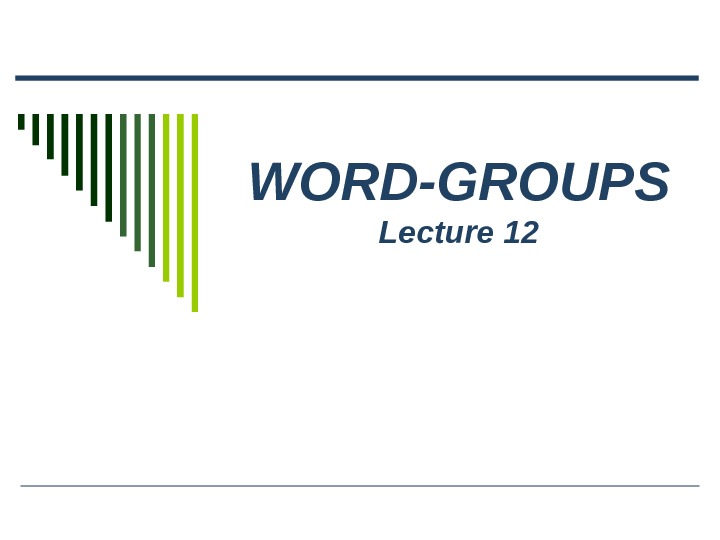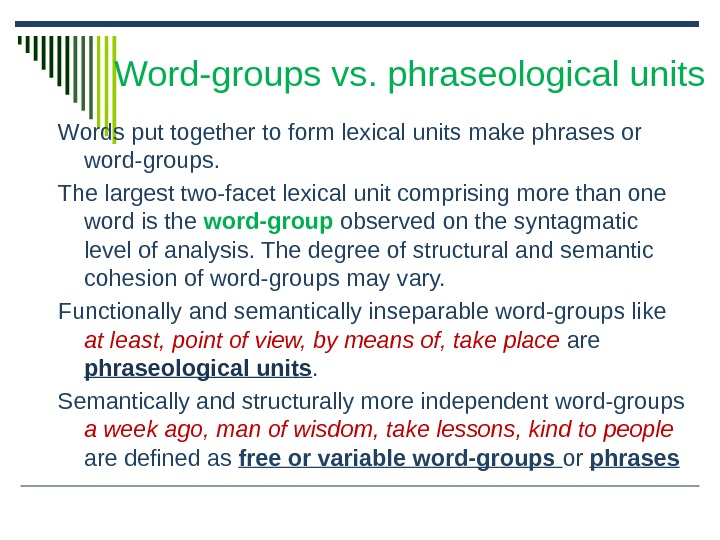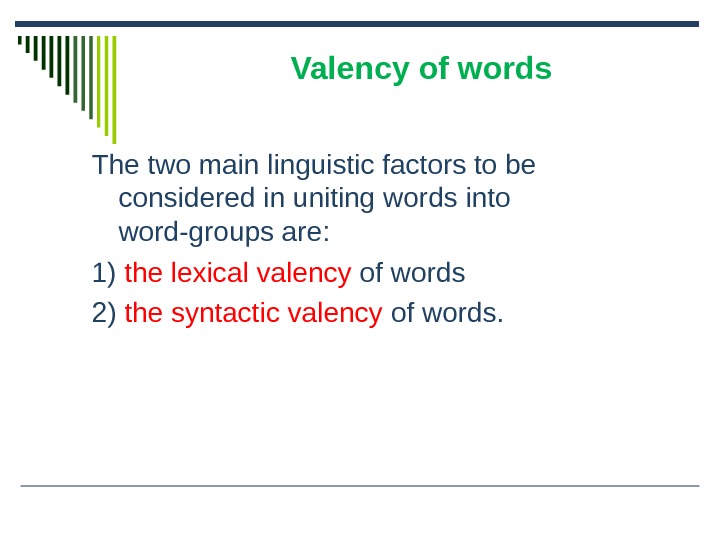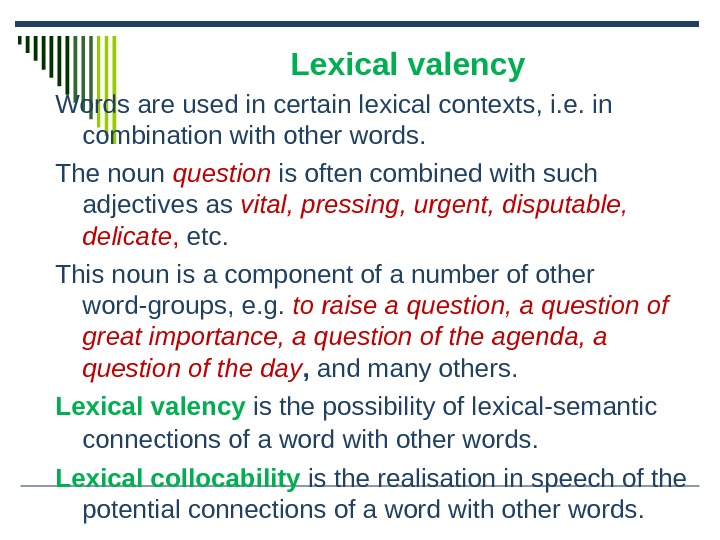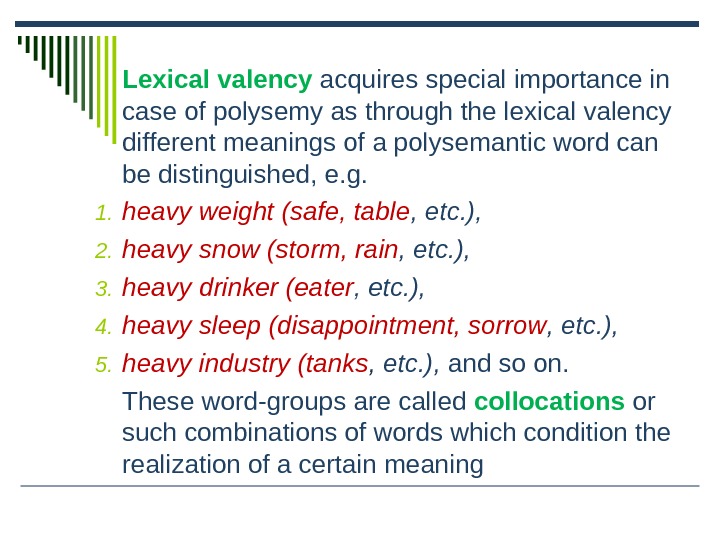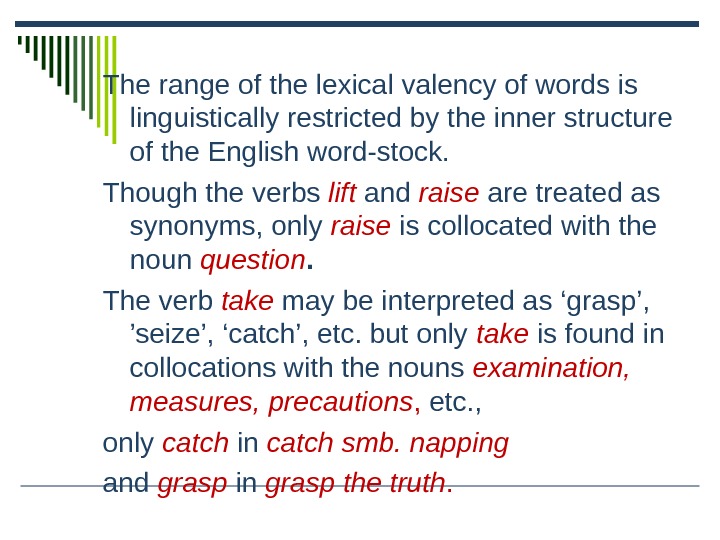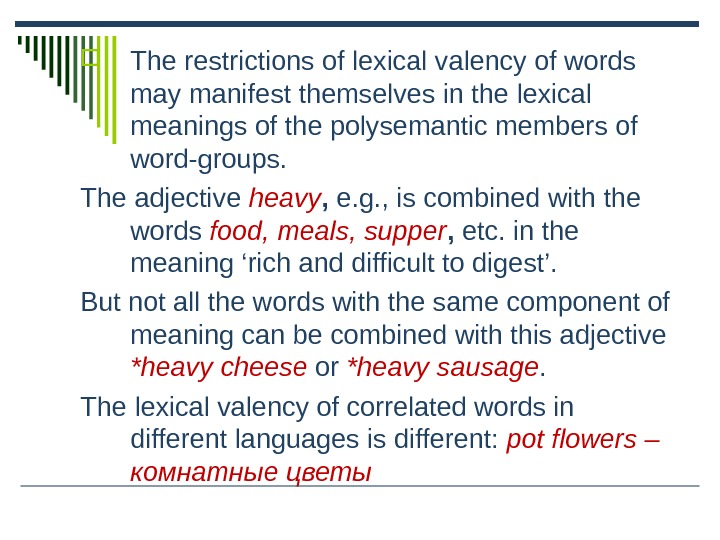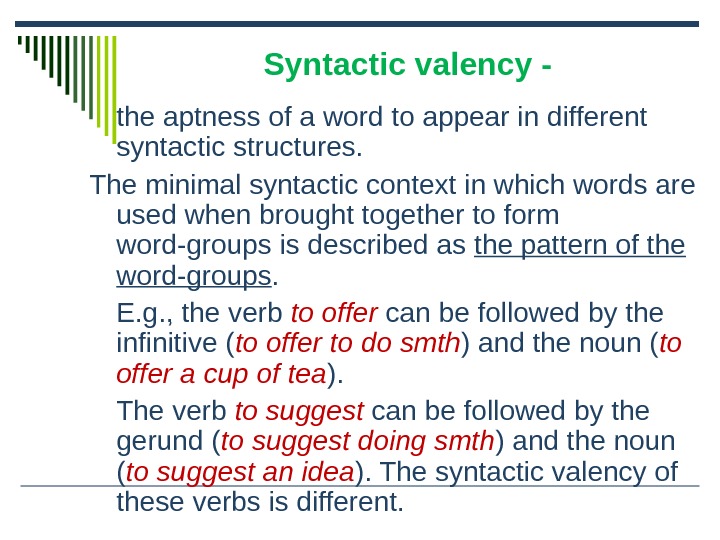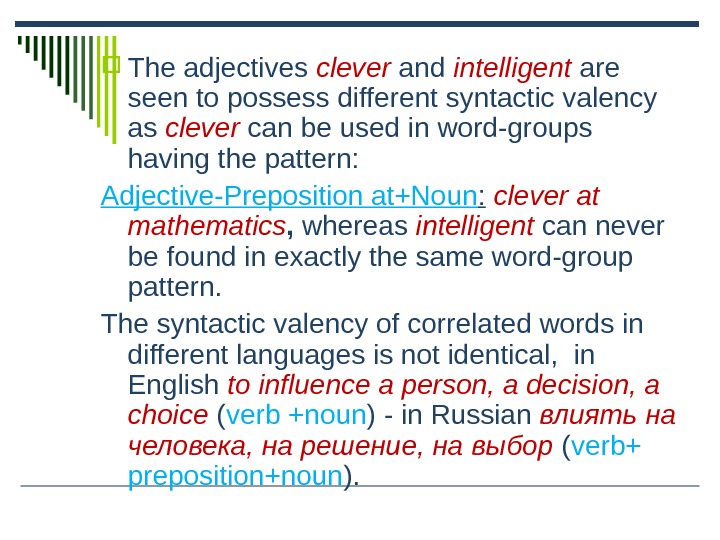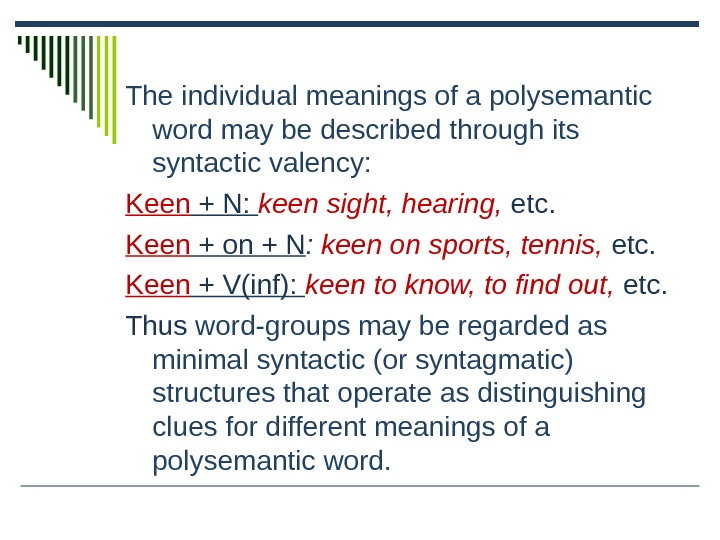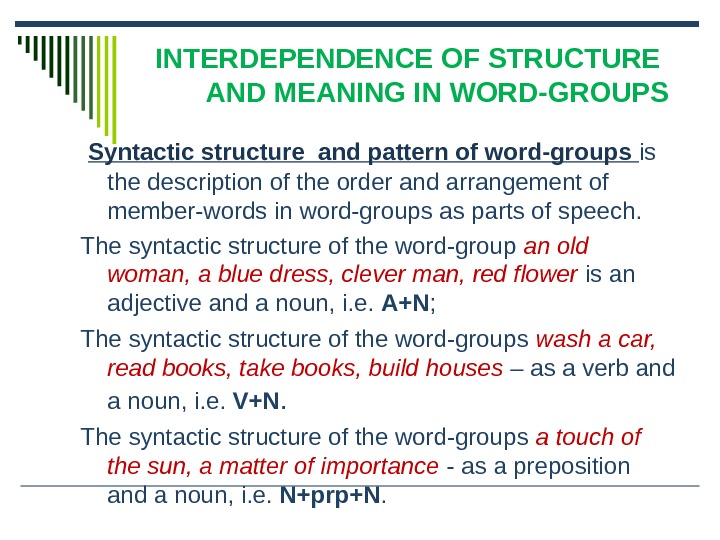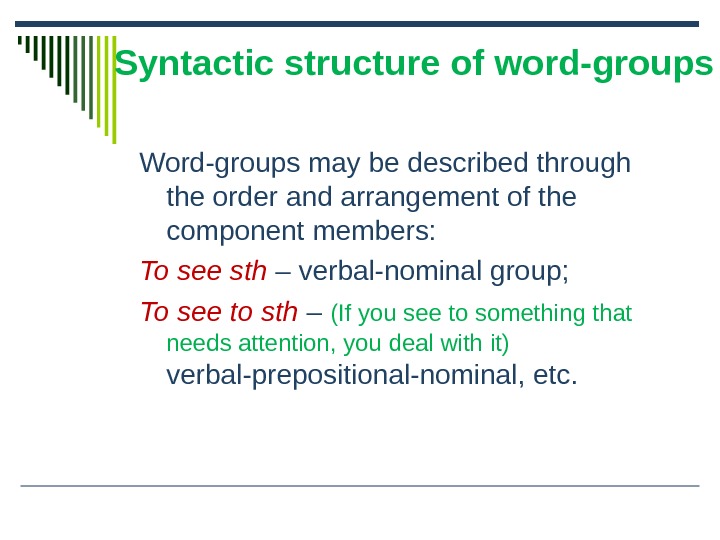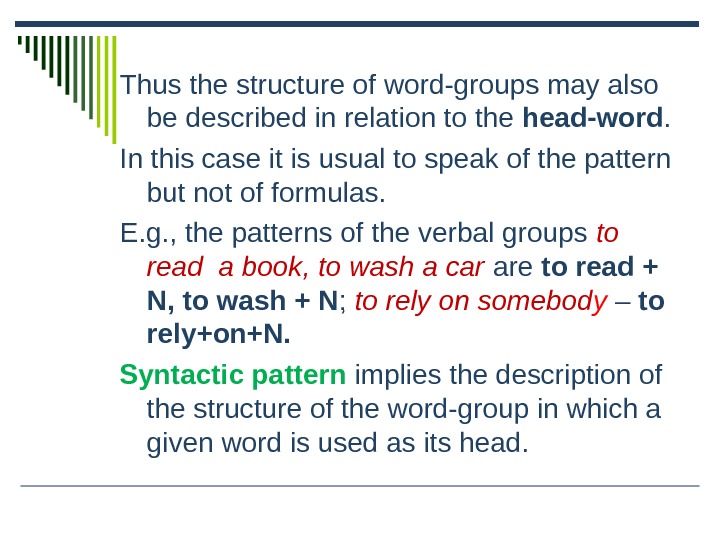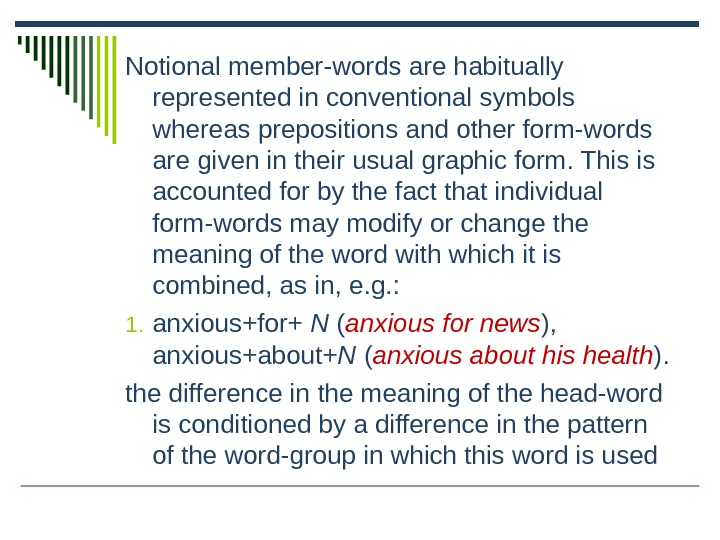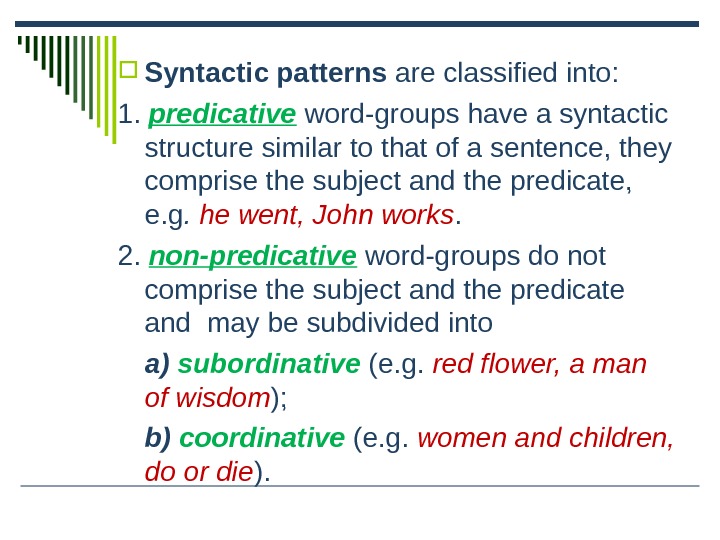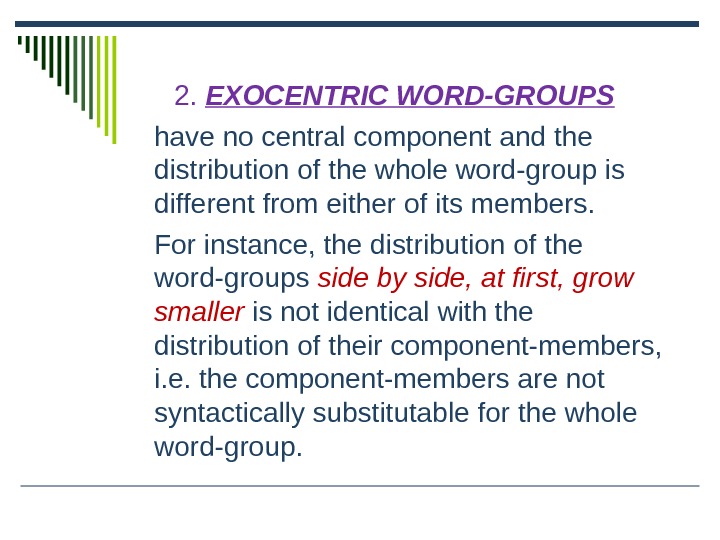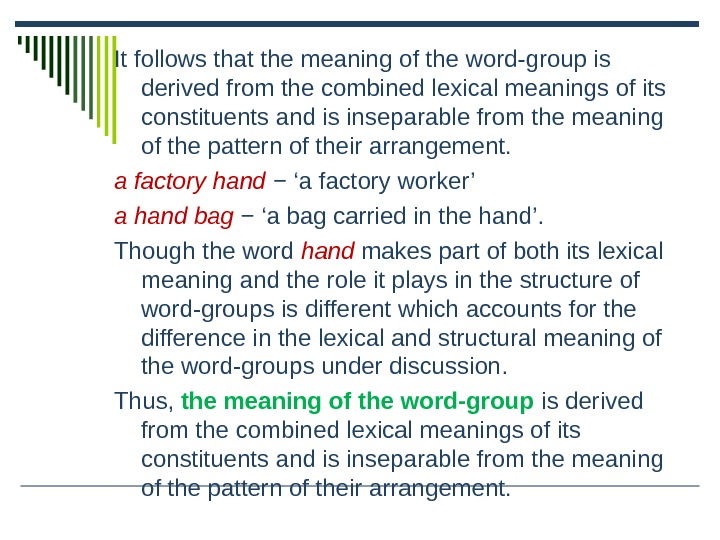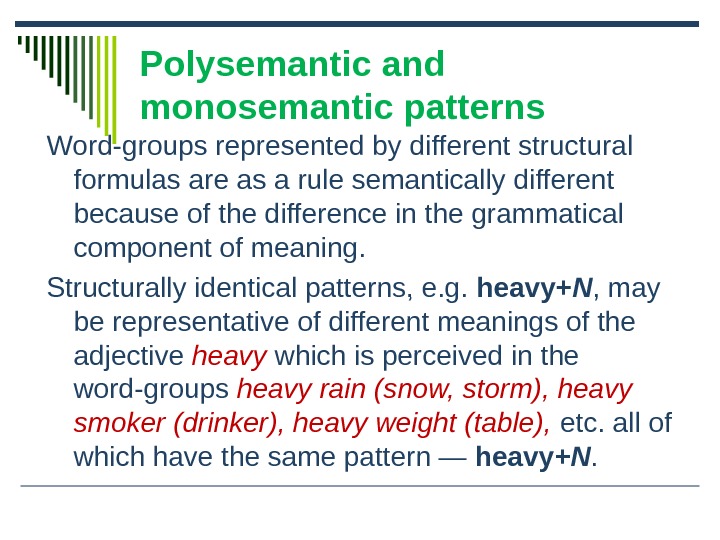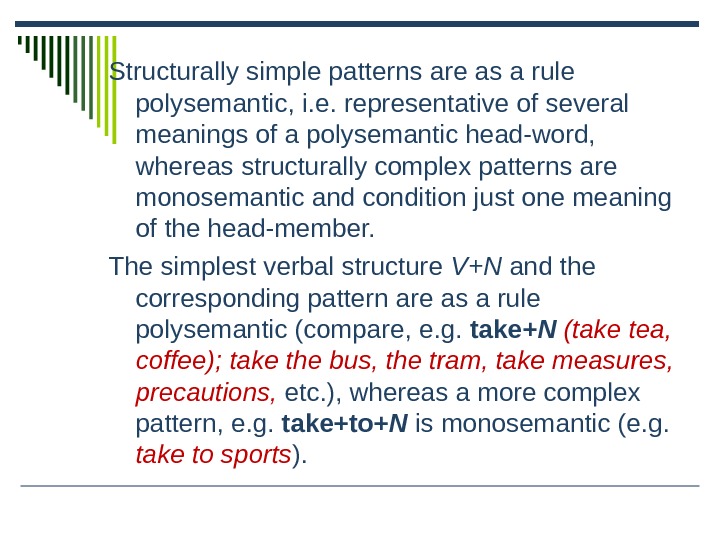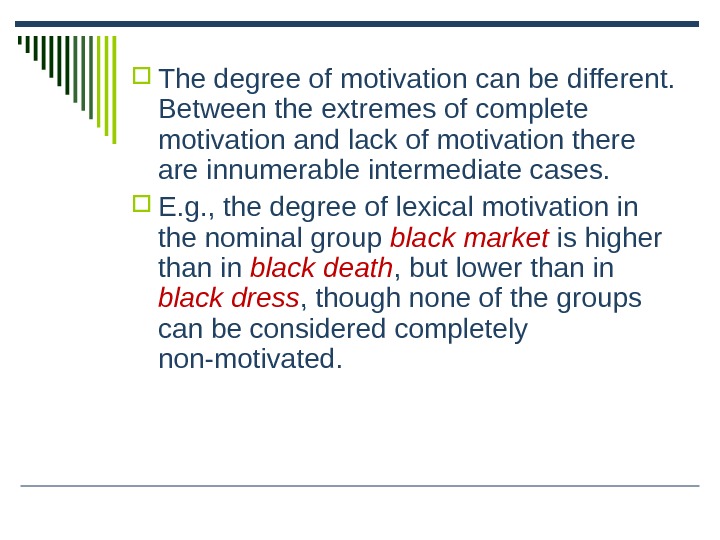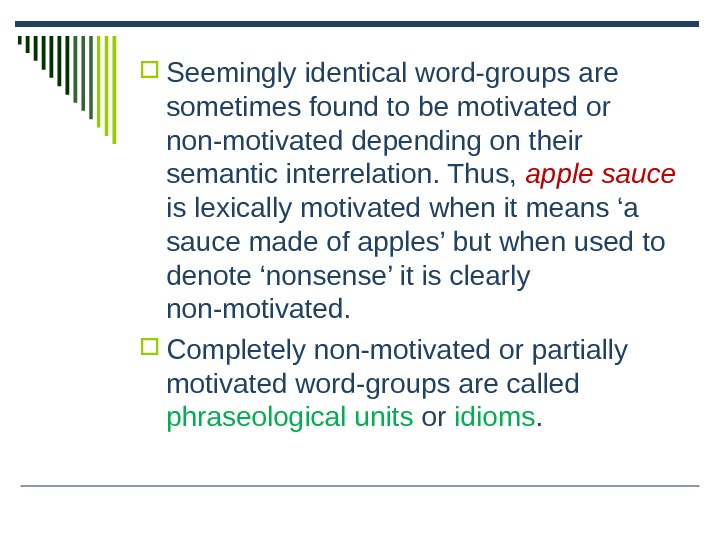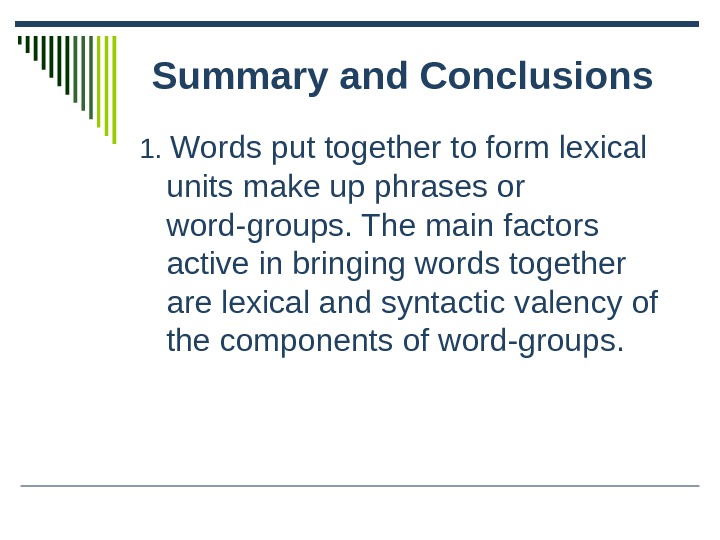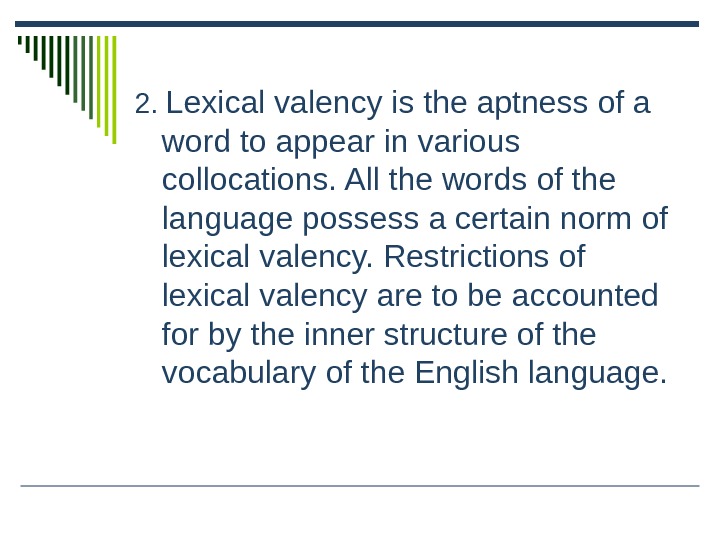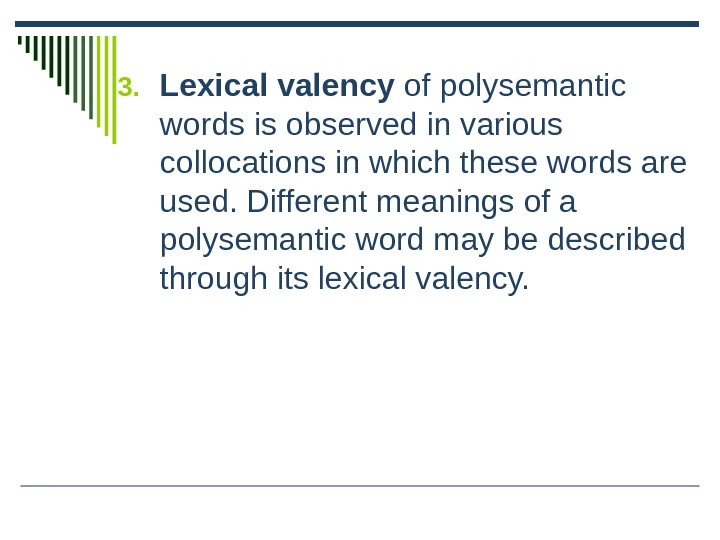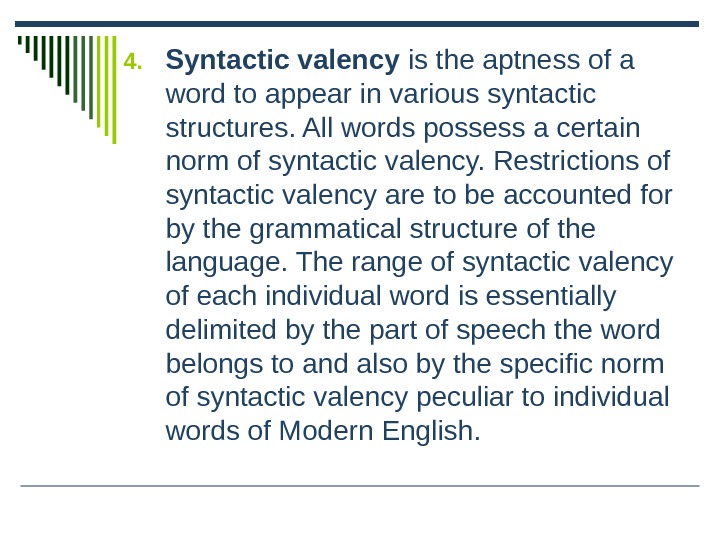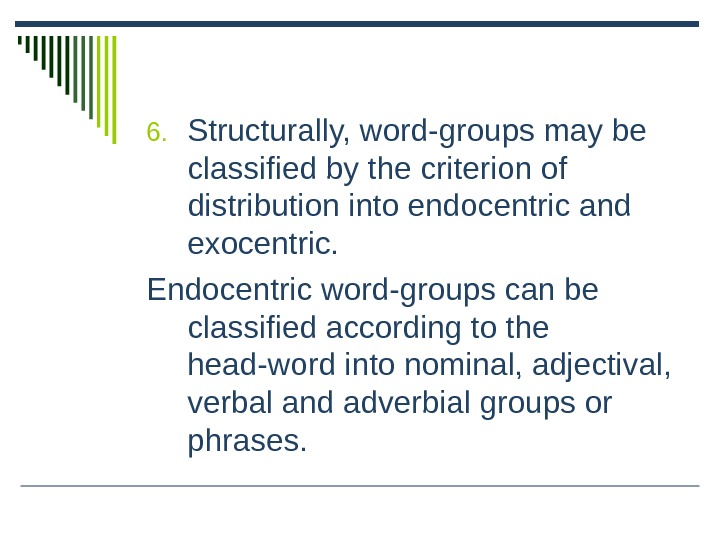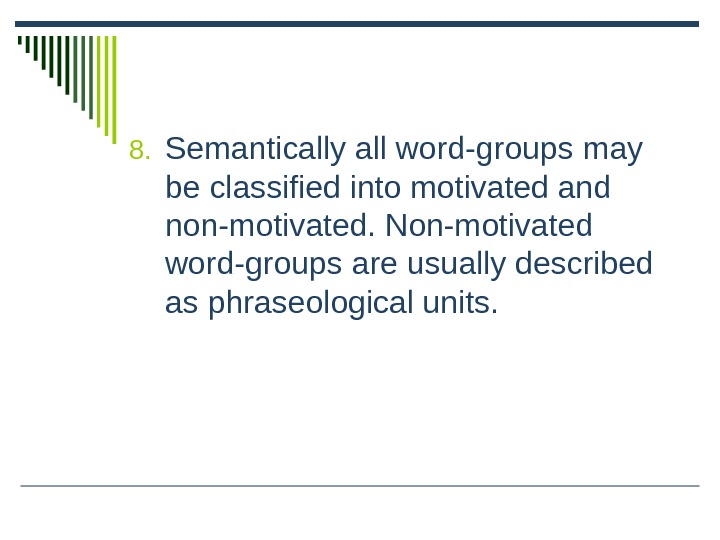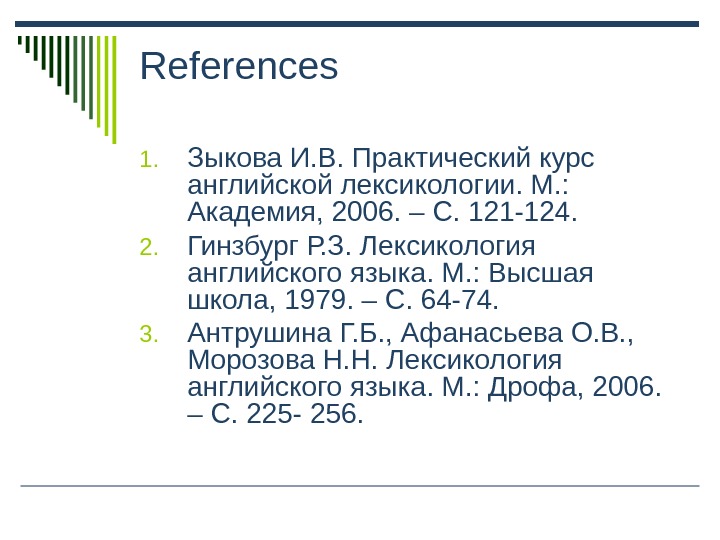Phraseological
units, or
idioms,
as
they are called by most western scholars, represent what can probably
be described as the most picturesque, colourful and expressive part
of the language’s vocabulary.
Phraseological
unit / set expression / idiom – a complex word-equivalent in which
the globality of nomination reigns supreme over the formal
separability of elements. It is reproduced in speech. – See Idiom
proper
The
vocabulary of a language is enriched not only by words but also by
phraseological units. Phraseological units are word-groups that
cannot be made in the process of speech, they exist in the language
as ready-made units. They are compiled in special dictionaries. The
same as words phraseological units express a single notion and are
used in a sentence as one part of it. American and British
lexicographers call such units «idioms».
Phraseological
units can be classified according to the ways they are formed,
according to the degree of the motivation of their meaning, according
to their structure and according to their part-of-speech meaning.
There
are two major criteria for distinguishing between phraseological
units and free word-groups: semantic and structural.
Compare
the following examples:
A. Cambridge
don: I’m told they’re inviting more American professors to this
university. Isn’t it rather carrying coals to Newcastle?
(To
carry coals to Newcastle means
«to take something to a place where it is already plentiful and
not needed». Cf.
with
the R. В
Тулу
со
своим
самоваром.)
B. This
cargo ship is carrying coal to Liverpool.
The
first thing that captures the eye is the semantic difference of the
two word-groups consisting of the same essential constituents. In the
second sentence the free word-group is carrying
coal is
used in the direct sense, the word coal
standing
for real hard, black coal and carry
for
the plain process of taking something from one place to another. The
first context quite obviously has nothing to do either with coal or
with transporting it, and the meaning of the whole word-group is
something
entirely new and far removed from the current meanings of the
constituents.
Academician
V. V. Vinogradov spoke of the semantic change in phraseological units
as «a meaning resulting from a peculiar chemical combination of
words». This seems a very apt comparison because in both cases
between which the parallel is drawn an entirely new quality comes
into existence.
Most
Russian scholars today accept the
semantic criterion of
distinguishing phraseological units from free word-groups as the
major one and base their research work in the field of phraseology on
the defini tion of a phraseological unit offered by Professor A. V.
Koonin, the leading authority on problems of English phraseology in
our country:
«A
phraseological unit is a stable word-group characterised by a
completely or partially transferred meaning.»
The
structural criterion also
brings forth pronounced distinctive features characterising
phraseological units and contrasting them to free word-groups.
Structural
invariability is an essential feature of phraseological units,
though, as we shall see, some of them possess it to a lesser degree
than others. Structural invariability of phraseological units finds
expression in a number of restrictions.
First
of all, restriction in substitution. As a rule, no word can be
substituted for any meaningful component of a phraseological unit
without destroying its sense. At the same time, in free word-groups
substitution does not present any dangers and does not lead to any
serious consequences.
The
second type of restriction is the restriction in introducing any
additional components into the structure of a phraseological unit.
In
a free word-group such changes can be made without affecting the
general meaning of the utterance: This
big ship is carrying a large cargo of coal to the port of Liverpool.
In
the phraseological unit to
carry coals to Newcastle no
additional components can be introduced.
The
third type of structural restrictions in phraseological units is
grammatical invariability. A typical mistake with students of English
is to use the plural form of fault
in
the phraseological unit to find
fault with somebody (e.
g. The
teacher always found faults with the boy). Though
the plural form in this context is logically well-founded, it is a
mistake in terms of the grammatical invariability of phraseological
units
Соседние файлы в предмете [НЕСОРТИРОВАННОЕ]
- #
- #
- #
- #
- #
- #
- #
- #
- #
- #
- #
LECTURE 13.
PHRASEOLOGY: PRINCIPLES OF CLASSIFICATION
1) Free word-groups versus phraseological units versus words
a) Structural Criterion
b) Semantic criterion
c) Syntactic Criterion
2) Semantic structure of phraseological units
3) Types of transference of phraseological units
4) Classifications of phraseological units
a) Thematic principle of classification of phraseological units
b) Academician V.V. Vidogradov’s classification of phraseological units
c) Structural principle of classification of phraseological units
d) Professor Smirnitsky’s classification of phraseological units
e) Professor A.V. Koonin’s classification of phraseological units
f) Classification of phraseological units on the base of their origin
1. Free word-groups versus phraseological units versus words
A phraseological unit can be defined as a reproduced and idiomatic (non-motivaetd) or partially morivated unit built up according to the model of free word-groups (or sentences) and semantically and syntactically brought into correlation with words. Hence, there is a need for criteria exposing the degree of similarity / difference between phraseological units and free word-groups, phraseological units and words.
a) Structural Criterion
The structural criterion brings forth pronounced features which on the one hand state a certain structural similarity between phraseological units and free word-combinations at the same time opposing them to single words (1), and on the other hand specify their structural distinctions (2).
1) A feature proper both to free phrases and phraseological units is the divisibility (раздельнооформленность) of their structure, i.e. they consist of separate structural elements. This fact stands them in opposition to words as structurally integral (цельнооформленные) units. The structural integrity of a word is defined by the presence of a common grammatical form for all constituent elements of this word. For example, the grammatical change in the word shipwreck implies that inflexions are added to both elements of the word simultaneously — ship-wreck-( ), ship-wreck-s, while in the word-group the wreck of a ship each element can change its grammatical form independently from the other — (the) wreck-( ) of the ships, (the) wrecks of (the) ships. Like in word-groups, in phraseological units potentially any component may be changed grammatically, but these changes are rather few, limited and occasional and usually serve for a stylistic effect, e.g. a Black Maria ‘a van used by police for bringing suspected criminals to the police station’: the Blackest Maria, Black Marias.
2) The principal difference between phraseological units and free word-groups manifests itself in the structural invariability of the former. The structural invariability suggests no (or rather limited) substitutions of components. For example, to give somebody the cold shoulder means ‘to treat somebody coldly, to ignore or cut him’, but a warm shoulder or a cold elbow makes no sense. There are also strict restrictions on the componental extension and grammatical changes of components of phraseological units. The use of the words big, great in a white elephant meaning ‘an expensive but useless thing’ can change or even destroy the meaning of the phraseological unit. The same is true if the plural form feet in the phraseological unit from head to foot is used instead of the singular form. In a free word-group all these changes are possible.
b) Semantic criterion
The semantic criterion is of great help in stating the semantic difference/similarity between free word-groups and phraseological units, (1), and between phraseological units and words (2).
1) The meaning in phraseological units is created by mutual interaction of elements and conveys a single concept. The actual meaning of a phraseological unit is figurative (transferred) and is opposed to the literal meaning of a word-combination from which it is derived. The transference of the initial word-group can be based on simile, metaphor, metonymy, and synecdoche. The degree of transference varies and may affect either the whole unit or only one of its constituents, cf.: to skate on thin ice – ‘to take risks’; the small hours — ‘the early hours of the morning’. Besides, in the formation of the semantic structure of phraseological units a cultural component plays a special and very important role. It marks phraseological units as bearers of cultural information based on a unique experience of the nation. For example, the phraseological unit red tape originates in the old custom of Government officials and lawyers tying up (перевязывать) their papers with red tape. Heads or tails comes from the old custom of deciding a dispute or settling which of two possible alternatives shall be followed by tossing a coin (heads refers to the sovereign’s head on one side of the coin, and tails means the reverse side).
In a free phrase the semantic correlative ties are fundamentally different. The meaning in a word-group is based on the combined meaning of the words constituting its structure. Each element in a word-combination has a much greater semantic independence and stands for a separate concept, e.g. to cut bread, to cut cheese, to eat bread. Every word in a free phrase can form additional syntactic ties with other words outside the expression retaining its individual meaning.
2) The semantic unity, however, makes phraseological units similar to words. The semantic similarity between the two is proved by the fact that, for instance, kick the bucket whose meaning is understood as a whole and not related to the meaning of individual words can be replaced within context by the word to die, the phraseological unit in a brown study – by the word gloomy.
c) Syntactic Criterion
The syntactic criterion reveals the close ties between single words and phraseological units as well as free word-groups. Like words (as well as word-combinations), phraseological units may have different syntactic functions in the sentence, e.g. the subject (narrow escape, first night, baker’s dozen), the predicate (to have a good mind, to play Russian roulette, to make a virtue of necessity), an attribute (high and mighty, quick on the trigger, as ugly as sin), an adverbial (in full swing, on second thoughts, off the record). In accordance with the function they perform in the sentence phraseological units can be classified into: substantive, verbal, adjectival, adverbial, interjectional.
Like free word-groups phraseological units can be divided into coordinative (e.g. the life and soul of something, free and easy, neck and crop) and subordinative (e.g. long in the tooth, a big fish in a little pond, the villain of the piece).
Thus, the characteristic features of phraseological units are: ready-made reproduction, structural divisibility, morphological stability, permanence of lexical composition, semantic unity, syntactic fixity.
2. Semantic structure of phraseological units
The semantic structure of phraseological units is formed by semantic ultimate constituents called macrocomponents of meaning. The macrocomponental model of phraseological meaning was worked out by V.N. Teliya. There are the following principal macrocomponents in the semantic structure of phraseological units:
1. Denotational (descriptive) macrocomponent that contains the information about the objective reality, it is the procedure connected with categorization, i.e. the classification of phenomena of the reality, based on the typical idea about what is denoted by a phraseological unit, i.e. about the denotatum.
2. Evaluational macrocomponent that contains information about the value of what is denoted by a phraseological unit, i.e. what value the speaker sees in this or that object/phenomenon of reality – the denotatum. The rational evaluation may be positive, negative and neutral, e.g. a home from home – ‘a place or situation where one feels completely happy and at ease’ (positive), the lion’s den — ‘a place of great danger’ (negative), in the flesh — ‘in bodily form’ (neutral). Evaluation may depend on empathy (i.e. a viewpoint) of the speaker/ hearer.
3. Motivational macrocomponent that correlates with the notion of the inner form of a phraseological unit, which may be viewed as the motif of transference, the image-forming base, the associative-imaginary complex, etc. The notion ‘motivation of a phraseological unit’ can be defined as the aptness of ‘the literal reading’ of a unit to be associated with the denotational and evaluational aspects of meaning. For example, the literal reading of the phraseological unit to have broad shoulders evokes associations connected with physical strength of a person. The idea that broad shoulders are indicative of a person’s strength and endurance actualizes, becomes the base for transference and forms the following meaning: ‘to be able to bear the full weight of one’s responsibilities’.
4. Emotive macrocomponent that is the contents of subjective modality expressing feeling-relation to what is denoted by a phraseological unit within the range of approval/disapproval, e.g. a leading light in something —‘a person who is important in a particular group’ (spoken with approval), to lead a cat and dog life — ‘used to describe a husband and wife who quarrel furiously with each other most of the time’ (spoken with disapproval). Emotiveness is also the result of interpretation of the imaginary base (образное основание) in a cultural aspect.
5. Stylistic macrocomponent that points to the communicative register in which a phraseological unit is used and to the social-role relationships between the participants of communication, e.g. sick at heart — ‘very sad’ (formal), be sick to death —‘to be angry and bored because something unpleasant has been happening for too long’ (informal), pass by on the other side — ‘to ignore a person who needs help’ (neutral).
6. Grammatical macrocomponent that contains the information about all possible morphological and syntactic changes of a phraseo¬logical unit, e.g. to be in deep water = to be in deep waters; to take away smb’s breath = to take smb’s breath away; Achilles’ heel = the heel of Achilles.
7. Gender macrocomponent (was singled out by I.V. Zykova) that may be expressed explicitly, i.e. determined by the structure and/or semantics of a phraseological unit, and in that case it points out to the class of objects denoted by the phraseological unit: men, women, people (both men and women). For example, compare the phraseological units every Tom, Dick and Harry meaning ‘every or any man’ and every Tom, Dick and Sheila which denotes ‘every or any man and woman’. Gender macrocomponent may be expressed implicitly and then it denotes the initial (or historical) reference of a phraseological unit to the class of objects denoted by it which is as a rule stipulated by the historical development, traditions, stereotypes, cultural realia of the given society, e.g. to wash one’s dirty linen in public — ‘discuss or argue about one’s personal affairs in public’. The implicit presence of the gender macrocomponent in this phraseo- logical unit is conditioned by the idea about traditional women’s work (cf. with Russian: выносить cop из избы). Gender, implicitly as well as explicitly expressed, reveals knowledge about such cultural concepts as masculinity and femininity that are peculiar to this or that society. The implicit gender macrocomponent is defined within the range of three conceptual spheres: masculine, feminine, intergender. Compare, for instance, the implicitly expressed intergender macrocomponent in to feel like royalty meaning ‘to feel like a member of the Royal Family, to feel majestic’ and its counterparts, i.e. phraseological units with explicitly expressed gender macrocomponent, to feel like a queen and to feel like a king.
3. Types of transference of phraseological units
Phraseological transference is a complete or partial change of meaning of an initial (source) word-combination (or a sentence) as a result of which the word-combination (or the sentence) acquires a new meaning and turns into a phraseological unit. Phraseological transference may be based on simile, metaphor, metonymy, synecdoche, etc. or on their combination.
1) Transference based on simile is the intensification of some feature of an object (phenomenon, thing) denoted by a phraseological unit by means of bringing it into contact with another object (phenomenon, thing) belonging to an entirely different class. Compare the following English and Russian phraseological units: (as) pretty as a picture — хороша как картинка, (as) fat as a pig — жирный как свинья, to fight like a lion — сражаться как лев, to swim like a fish — плавать как рыба.
2) Transference based on metaphor is a likening (уподобление) of one object (phenomenon, action) of reality to another, which is associated with it on the basis of real or imaginable resemblance. For example, in the phraseological unit to bend somebody to one’s bow meaning ‘to submit someone’ transference is based on metaphor, i.e. on the likening of a subordinated, submitted person to a thing (bow) a good command of which allows its owner to do with it everything he wants to.
Metaphors can bear a hyperbolic character: flog a dead horse —‘waste energy on a lost cause or unalterable situation (букв, стегать дохлую лошадь). Metaphors may also have a euphemistic character which serves to soften unpleasant facts: go to one’s long rest, join the majority – ‘to die’.
3) Transference based on metonymy is a transfer of name (перенос наименования) from one object (phenomenon, thing, action, process, etc.) to another based on the contiguity of their properties, relations, etc’ The transfer of name is conditioned by close ties between the two objects, the idea about one object is inseparably linked with the idea about the other object. For example, the metonymical transference in the phraseological unit a silk stocking meaning ‘a rich, well-dressed man’ is based on the replacement of the genuine object (a man) by the article of clothing which was very fashionable and popular among men in the past.
4) Synecdoche is a variety of metonymy. Transference based on synecdoche is naming the whole by its part, the replacement of the common by the private, of the plural by the singular and vice versa. For example, the components flesh and blood in the phraseological unit in the flesh and blood meaning ‘in a material form’ as the integral parts of the real existence replace a person himself or any living being, see the following sentences: We’ve been writing to each other for ten years, but now he’s actually going to be here in the flesh and blood. Thousands of fans flocked to Dublin to see their heroes in the flesh and blood. Synecdoche is usually found in combination with other types of transference, e.g. metaphor: to hold one’s tongue — ‘to say nothing, to be discreet’.
4. Classifications of phraseological units
a) Thematic principle of classification of phraseological units
The traditional and oldest principle for classifying phraseological units is based on their original content and might be alluded to as «thematic» (although the term is not universally accepted). The approach is widely used in numerous English and American guides to idiom, phrase books, etc. On this principle, idioms are classified according to their sources of origin, ‘source’ referring to the particular sphere of human activity, of life of nature, of natural phenomena, etc. So, L. P. Smith gives in his classification groups of idioms used by sailors, fishermen, soldiers, hunters and associated with the realia, phenomena and conditions of their occupations. In Smith’s classification we also find groups of idioms associated with domestic and wild animals and birds, agriculture and cooking. There are also numerous idioms drawn from sports, arts, etc.
This principle of classification is sometimes called «etymological». The term does not seem appropriate since we usually mean something different when we speak of the etymology of a word or word-group: whether the word (or word-group) is native or borrowed, and, if the latter, what is the source of borrowing. It is true that Smith makes a special study of idioms borrowed from other languages, but that is only a relatively small part of his classification system. The general principle is not etymological.
Smith points out that word-groups associated with the sea and the life of seamen are especially numerous in English vocabulary. Most of them have long since developed metaphorical meanings which have no longer any association with the sea or sailors. Here are some examples.
To be all at sea — to be unable to understand; to be in a state of ignorance or bewilderment about something (e. g. How can I be a judge in a situation in which I am all at sea? I’m afraid I’m all at sea in this problem). V. H. Collins remarks that the metaphor is that of a boat tossed about, out of control, with its occupants not knowing where they are.
To sink or swim — to fail or succeed (e. g. It is a case of sink or swim. All depends on his own effort.)
In deep water — in trouble or danger.
In low water, on the rocks — in strained financial circumstances.
To be in the same boat with somebody — to be in a situation in which people share the same difficulties and dangers (e. g. I don’t like you much, but seeing that we’re in the same boat I’ll back you all I can). The metaphor is that of passengers in the life-boat of a sunken ship.
To sail under false colours — to pretend to be what one is not; sometimes, to pose as a friend and, at the same time, have hostile intentions. The metaphor is that of an enemy ship that approaches its intended prey showing at the mast the flag («colours») of a pretended friendly nation.
To show one’s colours — to betray one’s real character or intentions. The allusion is, once more, to a ship showing the flag of its country at the mast.
To strike one’s colours — to surrender, give in, admit one is beaten. The metaphor refers to a ship’s hauling down its flag (sign of surrender).
To weather (to ride out) the storm — to overcome difficulties; to have courageously stood against misfortunes.
To bow to the storm — to give in, to acknowledge one’s defeat.
Three sheets in(to) the wind (sl.) — very drunk.
Half seas over (sl.) — drunk.
The thematic principle of classifying phraseological units has real merit but it does not take into consideration the linguistic characteristic features of the phraseological units.
b) Academician V.V. Vidogradov’s classification of phraseological units
The classification system of phraseological units devised by V.V. Vinogradov is considered by some linguists of today to be outdated, and yet its value is beyond doubt because it was the first classification system which was based on the semantic principle. It goes without saying that semantic characteristics are of immense importance in phraseological units. It is also well known that in modern research they are often sadly ignored. That is why any attempt at studying the semantic aspect of phraseological units should be appreciated.
V.V. Vinogradov’s classification system is founded on the degree of semantic cohesion between the components of a phraseological unit. Units with a partially transferred meaning show the weakest cohesion between their components. The more distant the meaning of a phraseological unit from the current meaning of its constituent parts, the greater is its degree of semantic cohesion. Accordingly, V.V. Vinogradov classifies phraseological units according to the degree of idiomaticity. Here are three classes of phraseological units: phraseological fusions (сращения), phraseological unities (единства) and phraseological collocations (сочетания).
1) Phraseological combinations are word-groups with a partially changed meaning. They may be said to be clearly motivated, that is, the meaning of the unit can be easily deduced from the meanings of its constituents.
E. g. to be at one’s wits’ end, to be good at something, to be a good hand at something, to have a bite, to come off a poor second, to come to a sticky end (coll.), to look a sight (coll.), to take something for granted, to stick to one’s word, to stick at nothing, gospel truth, bosom friends.
2) Phraseological unities are word-groups with a completely changed meaning, that is, the meaning of the unit does not correspond to the meanings of its constituent parts. They are motivated units or, putting it another way, the meaning of the whole unit can be deduced from the meanings of the constituent parts; the metaphor, on which the shift of meaning is based, is clear and transparent.
E. g. to stick to one’s guns (~ to be true to one’s views or convictions. The image is that of a gunner or guncrew who do not desert their guns even if a battle seems lost); to sit on the fence (~ in discussion, politics, etc. refrain from committing oneself to either side); to catch/clutch at a straw/straws (~ when in extreme danger, avail oneself of even the slightest chance of rescue); to lose one’s head (~ to be at a loss what to do; to be out of one’s mind); to lose one’s heart to smb. (~ to fall in love); to lock the stable door after the horse is stolen (~ to take precautions too late, when the mischief is done); to look a gift horse in the mouth (= to examine a present too critically; to find fault with something one gained without effort); to ride the high horse (~ to behave in a superior, haughty, overbearing way. The image is that of a person mounted on a horse so high that he looks down on others); the last drop/straw (the final culminating circumstance that makes a situation unendurable); a big bug/pot, sl. (a person of importance); a fish out of water (a person situated uncomfortably outside his usual or proper environment).
3) Phraseological fusions are word-groups with a completely changed meaning but, in contrast to the unities, they are demotivated, that is, their meaning cannot be deduced from the meanings of the constituent parts; the metaphor, on which the shift of meaning was based, has lost its clarity and is obscure.
E. g. to come a cropper (to come to disaster); neck and crop (entirely, altogether, thoroughly, as in: He was thrown out neck and crop. She severed all relations with them neck and crop.); at sixes and sevens (in confusion or in disagreement); to set one’s cap at smb. (to try and attract a man; spoken about girls and women. The image, which is now obscure, may have been either that of a child trying to catch a butterfly with his cap or of a girl putting on a pretty cap so as to attract a certain person. In Vanity Fair: «Be careful, Joe, that girl is setting her cap at you.»); to leave smb. in the lurch (to abandon a friend when he is in trouble); to show the white feather (to betray one’s cowardice. The allusion was originally to cock fighting. A white feather in a cock’s plumage denoted a bad fighter); to dance attendance on smb. (to try and please or attract smb.; to show exaggerated attention to smb.).
c) Structural principle of classification of phraseological units
It is obvious that Acadimician V.V. Vinogradov’s classification system does not take into account the structural characteristics of phraseological units. On the other hand, the border-line separating unities from fusions is vague and even subjective. One and the same phraseological unit may appear motivated to one person (and therefore be labelled as a unity) and demotivated to another (and be regarded as a fusion). The more profound one’s command of the language and one’s knowledge of its history, the fewer fusions one is likely to discover in it.
The structural principle of classifying phraseological units is based on their ability to perform the same syntactical functions as words. In the traditional structural approach, the following principal groups of phraseological units are distinguishable.
A.Verbal. E. g. to run for one’s (dear) life, to get (win) the upper hand, to talk through one’s hat, to make a song and dance about something, to sit pretty (Amer. sl.).
B.Substantive. E. g. dog’s life, cat-and-dog life, calf love, white lie, tall order, birds of a feather, birds of passage, red tape, brown study.
C.Adjectival. E. g. high and mighty, spick and span, brand new, safe and sound. In this group the so-called comparative word-groups are particularly expressive and sometimes amusing in their unanticipated and capricious associations: (as) cool as a cucumber, (as) nervous as a cat, (as) weak as a kitten, (as) good as gold (usu. spoken about children), (as) pretty as a picture, as large as life, (as) slippery as an eel, (as) thick as thieves, (as) drunk as an owl (sl.), (as) mad as a hatter/a hare in March.
D. Adverbial. E. g. high and low (as in They searched for him high and low), by hook or by crook (as in She decided that, by hook or by crook, she must marry him), for love or money (as in He came to the conclusion that a really good job couldn’t be found for love or money), in cold blood (as in The crime was said to have been committed in cold blood), in the dead of night, between the devil and the deep sea (in a situation in which danger threatens whatever course of action one takes), to the bitter end (as in to fight to the bitter end), by a long chalk (as in It is not the same thing, by a long chalk).
E. Interjectional. E. g. my God/ by Jove! by George! goodness gracious! good Heavens! sakes alive! (Amer.)
d) Professor A.I. Smirnitsky’s classification of phraseological units
Professor Smirnitsky offered a classification system for English phraseological units which is interesting as an attempt to combine the structural and the semantic principles. Phraseological units in this classification system are grouped according to the number and semantic significance of their constituent parts. Accordingly two large groups are established:
A. One-summit units, which have one meaningful constituent (e. g. to give up, to make out, to pull out, to be tired, to be surprised1);
B. Two-summit and multi-summit units which have two or more meaningful constituents (e. g. black art, first night, common sense, to fish in troubled waters).
Within each of these large groups the phraseological units are classified according to the category of parts of speech of the summit constituent. So, one-summit units are subdivided into: a) verbal-adverbial units equivalent to verbs in which the semantic and the grammatical centres coincide in the first constituent (e. g. to give up); b) units equivalent to verbs which have their semantic centre in the second constituent and their grammatical centre in the first (e. g. to be tired); c) prepositional-substantive units equivalent either to adverbs or to copulas and having their semantic centre in the substantive constituent and no grammatical centre (e. g. by heart, by means of).
Two-summit and multi-summit phraseological units are classified into: a) attributive-substantive two-summit units equivalent to nouns (e. g. black art), b) verbal-substantive two-summit units equivalent to verbs (e. g. to take the floor), c) phraseological repetitions equivalent to adverbs (e. g. now or never); d) adverbial multi-summit units (e. g. every other day).
Professor A.I. Smirnitsky also distinguishes proper phraseological units which, in his classification system, are units with non-figurative meanings, and idioms, that is, units with transferred meanings based on a metaphor.
Professor A.V. Koonin, the leading Russian authority on English phraseology, pointed out certain inconsistencies in this classification system. First of all, the subdivision into phraseological units (as non-idiomatic units) and idioms contradicts the leading criterion of a phraseological unit suggested by Professor Smirnitsky: it should be idiomatic.
Professor Koonin also objects to the inclusion of such word-groups as black art, best man, first night in phraseology (in Professor Smirnitsky’s classification system, the two-summit phraseological units) as all these word-groups are not characterised by a transferred meaning. It is also pointed out that verbs with post-positions (e. g. give up) are included in the classification but their status as phraseological units is not supported by any convincing argument.
e) Professor A.V. Koonin’s classification of phraseological units
The classification system of phraseological units suggested by Professor A. V. Koonin is the latest out-standing achievement in the Russian theory of phraseology. The classification is based on the combined structural-semantic principle and it also considers the quotient of stability of phraseological units.
Phraseological units are subdivided into the following four classes according to their function in communication determined by their structural-semantic characteristics.
1) Nominative phraseological units are represented by word-groups, including the ones with one meaningful word, and coordinative phrases of the type wear and tear, well and good. The first class also includes word-groups with a predicative structure, such as as the crow flies, and, also, predicative phrases of the type see how the land lies, ships that pass in the night.
2) Nominative-communicative phraseological units include word-groups of the type to break the ice — the ice is broken, that is, verbal word-groups which are transformed into a sentence when the verb is used in the Passive Voice.
3) Phraseological units which are neither nominative nor communicative include interjectional word-groups.
4) Communicative phraseological units are represented by proverbs and sayings.
These four classes are divided into sub-groups according to the type of structure of the phraseological unit. The sub-groups include further rubrics representing types of structural-semantic meanings according to the kind of relations between the constituents and to either full or partial transference of meaning.
The classification system includes a considerable number of subtypes and gradations and objectively reflects the wealth of types of phraseological units existing in the language. It is based on truly scientific and modern criteria and represents an earnest attempt to take into account all the relevant aspects of phraseological units and combine them within the borders of one classification system.
f) Classification of phraseological units on the base of their origin
The consideration of the origin of phraseological units contributes to a better understanding of phraseological meaning. According to their origin all phraseological units may be divided into two big groups: native and borrowed.
a) The main sources of native phraseological units are:
1) Terminological and professional lexics, e.g. physics: center of gravity (центр тяжести), specific weight (удельный вес); navigation: cut the painter (обрубить канат) — ‘to become independent’, lower one’s colours (спустить свой флаг) — ‘to yield, to give in’; military sphere: fall into line (стать в строй) — ‘conform with others’;
2) British literature, e.g. the green-eyed monster —‘jealousy’ (W.Shakespeare); like Hamlet without the prince —‘the most important person at event is absent’ (W.Shakespeare); fall on evil days —‘live in poverty after having enjoyed better times’ (J.Milton); a sight for sore eyes — ‘a person or thing that one is extremely pleased or relieved to see’ (J.Swift); how goes the enemy? (Ch. Dickens) —‘what is the time?’; never say die —‘do not give up hope in a difficult situation’ (Ch.Dickens);
3) British traditions and customs, e.g. baker’s dozen —‘a group of thirteen’. In the past British merchants of bread received from bakers thirteen loaves instead of twelve and the thirteenth loaf was merchants’ profit.
4) Superstitions and legends, e.g. a black sheep —‘a less successful or more immoral person in a family or a group’. People believed that a black sheep was marked by the devil; the halcyon days —‘a very happy or successful period in the past’. According to an ancient legend a halcyon (зимородок) hatches/grows its fledglings in a nest that sails in the sea and during this period (about two weeks) the sea is completely calm;
5) Historical facts and events, personalities, e.g. as well be hanged (or hung) for a sheep as a lamb —‘something that you say when you are going to be punished for something so you decide to do something worse because your punishment will not be any more severe’. According to an old law a person who stole a sheep was sentenced to death by hanging, so it was worth stealing something more because there was no worse punishment; to do a Thatcher —‘to stay in power as prime minister for three consecutive terms (from the former Conservative prime minister Margaret Thatcher)’;
6) Phenomena and facts of everyday life, e.g. carry coals to Newcastle —‘to take something to a place where there is plenty of it available’. Newcastle is a town in Northern England where a lot of coal was produced; to get out of wood —‘to be saved from danger or difficulty’.
b) The main sources of borrowed phraseological units are:
1) the Holy Script, e.g. the left hand does not know what the right hand is doing —‘communication in an organization is bad so that one part does not know what is happening in another part’; the kiss of Judas — ‘any display of affection whose purpose is to conceal any act of treachery’ (Matthew XXVI: 49);
2) Ancient legends and myths belonging to different religious or cultural traditions, e.g. to cut the Gordian knot —‘to deal with a difficult problem in a strong, simple and effective way’ (from the legend saying that Gordius, king of Gordium, tied an intricate knot and prophesied that whoever untied it would become the ruler of Asia. It was cut through with a sword by Alexander the Great); a Procrustean bed —‘a harsh, inhumane system into which the individual is fitted by force, regardless of his own needs and wishes’ (from Greek Mythology, Procrustes — a robber who forced travelers to lie on a bed and made them fit by stretching their limbs or cutting off the appropriate length of leg);
3) Facts and events of the world history, e.g. to cross the Rubicon —‘to do something which will have very important results which cannot be changed after’. Julius Caesar started a war which resulted in victory for him by crossing the river Rubicon in Italy; to meet one’s Waterloo —‘be faced with, esp. after previous success, a final defeat, a difficulty or obstacle one cannot overcome (from the defeat of Napoleon at Waterloo 1815)’;
4) Variants of the English language, e.g. a heavy hitter —‘someone who is powerful and has achieved a lot’ (American); a hole card —‘a secret advantage that is ready to use when you need it’ (American); be home and hosed —‘to have completed something successfully’ (Australian);
5) Other languages (classical and modern), e.g. second to none —‘equal with any other and better than most’ (from Latin: nulli secundus); for smb’s fair eyes —‘because of personal sympathy, not be worth one’s deserts, services, for nothing’ (from French: pour les beaux yeux de qn.); the fair sex — ‘women’ (from French: le beau sex); let the cat out of the bag — ‘reveal a secret carelessly or by mistake’ (from German: die Katze aus dem Sack lassen); tilt at windmills —‘to waste time trying to deal with enemies or problems that do no exist’ (from Spanish: acometer molinos de viento); every dog is a lion at home — ‘to feel significant in the familiar surrounding’ (from Italian: ogni cane e leone a casa sua).
1. PHRASEOLOGY Lecture 13
2. 1. PHRASEOLOGY AND PHRASEOLOGICAL UNITS
Phraseology is a branch of linguistics which
studies different types of set expressions,
which like words name various objects
and phenomena.
They exist in the language as ready-made
units.
3.
A Phraseological unit (PU) can be defined as a
non-motivated word-group that cannot be
freely made up in speech, but is reproduced as
a ready-made unit.
It is a group of words whose meaning cannot be
deduced by examining the meaning of the
constituent lexemes.
The essential features of PU are:
1) lack of motivation;
2) stability of the lexical components.
4.
A dark horse — is actually not a horse but a
person about whom no one knows anything
definite.
A bull in a china shop — a clumsy person.
A white elephant – it is a waste of money
because it is completely useless.
The green-eyed monster is jealousy, the image
being drawn from Othello.
To let the cat out of the bag — to let some secret
become known.
5.
To bark up the wrong tree (Am) means ‘to follow a
false scent; to look for somebody or something in a
wrong place; to expect from somebody what he is
unlikely to do’.
The idiom is not infrequently used in detective stories:
The police are barking up the wrong tree as
usual, i.e. they suspect somebody who has nothing
to do with the crime.
The ambiguity of these interesting word-groups may
lead to an amusing misunderstanding, especially for
children who are apt to accept words at their face
value.
6.
— Little Johnnie (crying): Mummy, mummy, my
auntie Jane is dead.
— Mother: Nonsense, child! She phoned me 5
minutes ago.
— Little Johnnie: But I heard Mrs. Brown say
that her neighbours cut her dead.
To cut somebody dead means ‘to rudely ignore
somebody; to pretend not to know or
recognize him’.
7. Puns are frequently based on the ambiguousness of idioms:
— Isn’t our Kate a marvel! I wish you could have seen
her at the Harrisons’ party yesterday. If I’d collected
the bricks she dropped all over the place, I could
built a villa’.
To drop a brick means ‘to say unintentionally a quite
indiscreet or tactless thing that shocks and offended
people’.
8.
The author of the “Book of English Idioms”
Collins writes: “In standard spoken and
written English today idioms is an established
and essential element that, used with care,
ornaments and enriches the language.”
Used with care is an important warning because
speech overloaded with idioms loses its
freshness and originality. Idioms, after all, are
ready-made speech units, and their continual
repetition sometimes wears them out: they
lose their colours and become trite clichés.
9. In modern linguistics, there is considerable confusion about the terminology associated with these word-groups
In modern linguistics, there is considerable confusion
about the terminology associated with these wordgroups
Most Russian scholars use the term “phraseological
units” introduced by academician V.V. Vinogradov.
The term “idiom” used by western scholars has
comparatively recently found its way into Russian
phraseology but is applied mostly to only a certain
type of phraseological unit.
There are some other terms: set-expressions, setphrases, phrases, fixed word-groups, collocations.
10. The ‘freedom’ of free word-groups is relative and arbitrary.
Nothing is entirely ‘free’ in speech as its linear
relationships are governed, restricted and
regulated, on the one hand, by requirements of
logic and common sense and, on the other, by
the rules of grammar and combinability.
A black-eyed girl but not of a black-eyed table.
The child was glad is quite correct, but a glad
child is wrong.
11.
Free word-groups are so called not because of
any absolute freedom in using them but
simply because they are each time built up
anew in the speech process whereas idioms
are used as ready-made units with fixed and
constant structures.
12. FREE-WORD GROUPS vs PHRASEOLOGICAL UNITS
The border-line between free or variable word-groups and
phraseological units is not clearly defined.
The free word-groups are only relatively free as collocability
of their member-words is fundamentally delimited by
their lexical and syntactic valency.
Phraseological units are comparatively stable and
semantically inseparable.
Between the extremes of complete motivation and
variability of member-words and lack of motivation
combined with complete stability of the lexical
components and grammatical structure there are
innumerable border-line cases.
13. There are differences between word-groups and phraseological units
The difference often is in the interrelation of lexical components,
e.g.: Blue ribbon (or red, brown, etc.), but blue ribbon – an
honour given to the winner of the first prize in a competition
– no substitution is possible in a phraseological unit;
Stretch one’s legs – размять ноги, прогуляться (а не
«протянуть ноги»),
See eye to eye – быть полностью согласным (а не «видеться с
глазу на глаз»),
Under one’s hand – за собственной подписью (а не «под
рукой»),
Stew in one’s own juice – страдать по своей собственной
глупости (а не «вариться в собственном соку»).
14.
In free word-groups each of its constituents
preserves its denotational meaning.
In the case of phraseological units however the
denotational meaning belongs to the wordgroup as a single semantically inseparable
unit. For example, compare a free word-group
a white elephant (белый слон) and a
phraseological unit white elephant (обуза,
подарок, от которого не знаешь как
избавиться).
15. Distinctive features of free-word groups and phraseological units
Free word-groups
1.
2.
are formed in the
process of speech
according to the
standards of the
language;
are constructed in the
process of
communication by
joining together words
into a phrase;
Phraseological units
1.
exist in the language
side-by-side with
separate words;
2.
are reproduced in
speech as ready-made
units;
16.
Free word-groups
Phraseological units
3.
substitution is possible;
3.
no substitution is
possible;
4.
each of its components
preserves its
denotational meaning;
4.
the denotational
meaning belongs to the
word group as a single
semantically
inseparable unit;
17.
Free word-groups
Phraseological units
5.
less structural unity;
5.
greater structural unity;
6.
components may have
any of the forms of
their paradigm.
6.
components often have
just one form of all the
forms of their
paradigm.
18.
Free word-groups are but relatively free: they
may possess some of the features
characteristic of phraseological units.
On the other hand, phraseological units are
heterogeneous. Alongside absolutely
unchangeable phraseological units, there are
expressions that allow some degree of
substitution. Phraseology is concerned with
all types of set expressions including those
that stand for certain sentences.
19. 3. CLASSIFICATIONS OF PHRASEOLOGICAL UNITS
3.1. SEMANTIC CLASSIFICATION OF
PHRASEOLOGICAL UNITS (V.V. Vinogradov)
is based on the motivation of the unit
1.
Phraseological fusions are units whose meaning
cannot be deduced from the meanings of their
component parts. The meaning of PFs is
unmotivated at the present stage of language
development, e.g.
red tape (бюрократизм, волокита),
a mare’s nest (иллюзия, нечто несуществующее),
My aunt! (вот те на!, вот так штука!, ну и ну!).
The meaning of the components is completely
absorbed by the meaning of the whole;
20.
2.
Phrasological unities are expressions the
meaning of which can be deduced from the
meanings of their components; the meaning
of the whole is based on the transferred
meanings of the components, e.g.
to show one’s teeth (to be unfriendly),
to stand to one’s guns (to refuse to change
one’s opinion), etc.
They are motivated expressions.
21.
Phraseological collocations are not only motivated
but contain one component used in its direct
meaning, while the other is used metaphorically,
e.g. to meet requirements, to attain success.
In this group of PUs some substitutions are possible
which do not destroy the meaning of the metaphoric
element, e.g. to meet the needs, to meet the
demand, to meet the necessity; to have success,
to lose success.
These substitutions are not synonymical and the
meaning of the whole changes, while the meaning
of the verb meet and the noun success are kept
intact.
3.
22. 3.2. STRUCTURAL CLASSIFICATION OF PHRASEOLOGICAL UNITS (A.I. SMIRNITSKY)
Prof. A.I. Smirnitsky classified PUs as highly idiomatic
set expressions functioning as word equivalents, and
characterized by their semantic and grammatical
unity. He suggested three classes of stereotyped
phrases:
1. traditional phrases (nice distinction, rough sketch);
2. phraseological combinations (to fall in love, to get
up);
3. idioms (to wash one’s dirty linen in public);
23.
The second group (phraseological combinations)
fall into two subgroups:
1.
one-top phraseological units, which were
compared with derived words;
1.
2.
3.
verb-adverb PUs of the type to give up, e.g. to
bring up, to try out, to look up, to drop in, etc.
PUs of the type to be tired, e.g. to be surprised,
to be up to, etc.
Prepositional substantative units, e.g. by heart.
24.
2. two-top phraseological units, which were
compared with compound words.
1.
2.
3.
4.
attributive-nominal, e.g. brains trust, white
elephant, blind alley. Units of this type function
as noun equivalents;
verb-nominal phrases, e.g. to know the ropes,
to take place, etc.
phraseological repetitions, e.g. ups and downs ,
rough and ready, flat as a pancake. They
function as adverbs or adjectives equivalents;
adverbial multi-top units, e.g. every other day.
25. STRUCTURAL-SEMANTIC CLASSIFICATION OF PHRASEOLOGICAL UNITS (A.V. Koonin)
Prof. Koonin distinguishes: phraseological units,
phraseomatic units and borderline (mixed)
cases. phraseological units have fully or partly
transferred meaning, while phraseomatic units
are used in their literal meaning.
Phraseological and phraseomatic units are
characterized by phraseological stability that
distinguishes them from free phrases and
compound words.
26. Prof. A.V. Koonin develops the theory of stability which consists of the following aspects:
Prof. A.V. Koonin develops the theory of
stability which consists of the following aspects:
1.
2.
stability of usage, i.e. phraseological units
are reproduced ready-made, not created in
speech;
lexical stability, i.e. the components of
phraseological units are either irreplaceable or
partially replaceable within the bounds of
phraseological variance:
27.
Lexical: a skeleton in the cupboard / closet (family’s secret), a
blind pig / tiger (to sell alcohol illegally);
Grammatical: to be in deep water / waters (to be in a dificult
situation), a stony heart – a heart of stone (a stern or cruel
nature);
Positional: a square peg in a round hole – a round peg in a
square hole (a person in a situation unsuited to their abilities or
character), to dot the i’s and cross the t’s – to cross one’s t’s
and dot one’s i’s (ensure that all details are correct);
Quantitative: Tom, Dick and Harry – every Tom, Dick and
Harry (anybody and everybody);
Mixed variants: raise/stir up the nest of hornets’ nest about
one’s ears – to arouse/stir up the nest of hornets (to destroy
the nest of wasps).
28.
3.
4.
Semantic stability is based on lexical
stability of phraseological units. In spite of
occasional changes the meaning of a
phraseological unit is preserved. It may only
be specified, made more precise, weakened or
strengthened.
Syntactic stability.
29. The characteristic features of phraseological units are:
1.
2.
3.
4.
5.
6.
ready-made reproduction,
structural divisibility,
morphological stability,
permanence of lexical composition,
semantic unity,
syntactic fixity.
30. Prof. A.V. Koonin’s definition: ‘a phraseplogical unit is a stable word-group with wholly or partially transferred meaning.’
Phraseological units are subdivided into 4
classes according to the function in
communication determined by structuralsemantic characteristics.
31. Functional classification
1.
2.
3.
4.
nominative phraseplogical units, standing for certain
notions: a bull in a china shop;
nominative-communicative phraseplogical units,
standing for certain notions in the Active voice, and may
be used in Passive constructions: to cross the Rubicon –
the Rubicon is crossed!
interjectional phraseplogical units, standing for certain
notions: a pretty (nice) kettle of fish! For crying out
loud!
communicative phraseological units standing for
sentences (proverbs and sayings): Still waters run deep.
The world is a nice place.
32. Communicative phraseological units, expressing statement:
1.
A proverb is a collection of words (phrase or
sentence that states a general truth or gives
advice:
Idleness is the root of all evil.
A penny saved is a penny gained.
The pen is mightier than the sword.
Ask no questions, hear no lies.
Silence is something an answer.
33. Distinctive features of proverbs:
1.
Structural dissimilarity
(cf: George liked her for she never put on
airs (predicate).
Big bugs like him care nothing about small
fry like ourselves (a) subject, b) prepositional
object).
Proverbs, if viewed in their structural aspect,
are sentences, and so cannot be used in the
way in which phraseological units are used in
the above examples.
34. 2. Semantic aspect:
Proverbs could be best compared with minute fables for,
like the latter, they sum up the collective experience
of the community. Proverbs:
1. moralize: Hell is paved with good intentions.
2. give advice: Don’t judge a tree by its bark .
3. give warning: If you sing before breakfast, you
will cry before night.
4. admonish: Liars should have good memories.
5. criticize: Everyone calls his own geese swans.
35. A saying is any common, colloquial expression, or a remark often made, e.g.
1.
2.
3.
4.
That cat won’t jump.
Woe betide you!
The fat is in the fire .
What will Mrs. Grundy say?
36. Proverbs and sayings are introduced in speech ready-made, their components are constant, and their meaning is traditional and mostly figurative.
Proverbs often form the basis for phraseological
units:
It’s the last straw that breaks the camel’s back:
the last straw.
There no use crying over spilt milk: cry over
spilt milk, spilt milk.
Generally proverbs and sayings are emotionally
coloured.
37. Proverbs are short sayings that express popular wisdom, a truth or a moral lesson in a concise and imaginative way:
It never rains, but it pours.
Easy come, easy go.
A miss is as good as a mile.
Too many chiefs and not enough Indians.
Least said, soonest mended.
Practice what one peaches.
You can’t teach an old dog new tricks.
Charity begins at home.
38. Many proverbs and sayings are metaphorical:
Time is money.
Little drops make the mighty ocean (little
drops).
Rome wasn’t built in a day. (a day);
Make the mighty ocean, building Rome (a
large task).
It takes two to tango (both parties involved in a
situation or argument are equally responsible
for it).
39. 3.3. SEMANTIC STRUCTURE OF PHRASEOLOGICAL UNITS BY PROF. V.N.TELIYA
The semantic structure of PUs is formed by
semantic ultimate constituents called
macrocomponents of meaning:
1. Denotational (descriptive) macrocomponent
contains the information about the objective
reality, it is the procedure connected with
categorization, i.e. the classification of
phenomena of the reality, based on the typical
idea about what is denoted by a PU.
40.
2. Evaluation macrocomponent contains
1.
2.
3.
the information about the value of what is
denoted by a PU.
The rational evaluation may be:
positive, e.g. a home from home – ‘a
place or situation where one feels
completely happy and at ease’;
negative, e.g. the lion’s den – ‘a place of
great danger’;
neutral, e.g., in the flesh – ‘in bodily
form’.
41.
3. Motivational macrocomponent correlates
with the notion of the inner form of PU.
Motivation of a PU can be defined as the
aptness of ‘the literal reading’ of a unit to be
associated with the denotational and
evaluation aspects of meaning.
E.g., the literal reading of the PU to have broad
shoulders is physical strength of a person.
The idea is indicative of a person’s strength
becomes the base for transference and forms
the meaning of: ‘being able to bear the full
weight of one’s responsibilities’.
42.
4. Emotive macrocomponent is the contents
of subjective modality expressing feelingrelation to what is denoted by a PU within the
range of approval/disapproval, e.g.
a leading light in something – ‘a person who is
important in a particular group’ (approval),
to lead a cat and dog life – ‘used to describe a
husband and wife who quarrel furiously with
each other most of the time’ (disapproval).
43.
5. Stylistic macrocomponent points to the
communicative register in which a PU is used
and to the social-role relationships between
the participants of communication:
1. formal, e.g. sick at heart – ‘very sad’;
2. informal, e.g. be sick to death – ‘to be
angry and bored because something
unpleasant has been happening for too
long’;
3. neutral, e.g. pass by on the other side – ‘to
ignore a person who needs help’.
44.
6. Grammatical macrocomponent contains the
information about all possible morphological
and syntactic changes of a PU, e.g. to be in
deep water = to be in deep waters;
to take away smb’s breath = to take smb’s
breath away;
Achilles’s heel = the heel of Achilles.
45.
7. Gender macrocomponent may be expressed
explicitly, i.e. determined by the structure
and/or semantics of a PU, and in that case it
points out to the class of objects denoted by
the PU: men, women, people (both men and
women).
E.g., compare the PUs every Tom, Dick and
Harry meaning ‘every or any man” and
every Tom, Dick and Sheila which denotes
‘every or any man and woman’.
46.
Gender macrocomponent may be expressed implicitly and
then it denotes the historical reference of a
phraseological unit: to wash one’s dirty linen in public.
The implicit idea about traditional women’s work (cf.
with Russian: выносить сор из избы).
The implicit gender macrocomponent is defined within
the range of three conceptual spheres: masculine,
feminine, intergender.
Cf. the implicitly expressed intergender
macrocomponent in to feel like royalty meaning ‘to feel
like a member of the Royal Family, to feel majestic’ and
its counterparts, i.e. phraseological units with explicitly
expressed gender macrocomponent, to feel like a queen
and to feel like a king.
47. 5. TYPES OF TRANSFERENCE OF PHRASEOLOGICAL UNITS
Phraseological transference is a complete or
partial change of meaning of an initial wordcombination (WC) or a sentence as a result of
which the WC (or the sentence) acquires a
new meaning and turns into a PU.
48.
1. Transference based on simile, is the
intensification of some features of an object
(phenomenon, thing) denoted by a PU by
means of bringing it into contact with another
object (phenomenon, thing) belonging to an
entirely different class. Compare:
(as) pretty as a picture
(as) fat as a pig
to fight like a lion
to swim like a fish
49.
2. Transference based on metaphor is a likening
of the object (phenomenon, action) of reality
to another, which is associated with it on the
basis of real or imaginable resemblance.
E.g., in the PU to bend somebody to one’s bow
meaning ‘to submit someone’ transference is
based on metaphor, i.e. on the likening of a
subordinated, submitted person to a thing
(bow) a good command of which allows its
owner to do with it everything he wants to.
50.
Metaphors can bear a hyperbolic character:
flog a dead horse .
Metaphors may also have a euphemistic
character which serves to soften unpleasant
facts: go to one’s long rest, join the majority
– ‘to die’.
51.
3. Transference based on metonymy is a
transfer of name from one object
(phenomenon, thing, etc.) to another based on
the contiguity of their properties, relations,
etc. It is conditioned by close ties between the
two objects, e.g., the metonymical
transference in the PU a silk stocking
meaning ‘a rich, well-dressed man’ is based
on the replacement of the genuine object (a
man) by the article of clothing which was
very fashionable and popular among men in
the past.
52.
4. Transference based on synecdoche is naming
the whole by its part, the replacement of the
common by the private, of the plural by the
singular and vice versa. E.g., the components
flesh and blood in the PU in the flesh and
blood meaning ‘in a material form’ as the
integral parts of the real existence replace a
person himself or any living being.
Synecdoche is usually used in combination
with other types of transference, e.g.
metaphor: to hold one’s tongue – ‘to say
nothing, to be discreet’.
53. References:
1.
2.
3.
Babich G.N. Lexicology: a Current Guide.
Екатеринбург – Москва: изд-во «Белая
медведица», 2006. С. – 101-112.
Zykova I.V. Practical Course in English
Lexicology. M.: Academy, 2006. Pp. -128134.
Антрушина Г.Б. Лексикология
английского языка. М.: Дрофа, 2006.
С.225-259.
- Размер: 211 Кб
- Количество слайдов: 39
